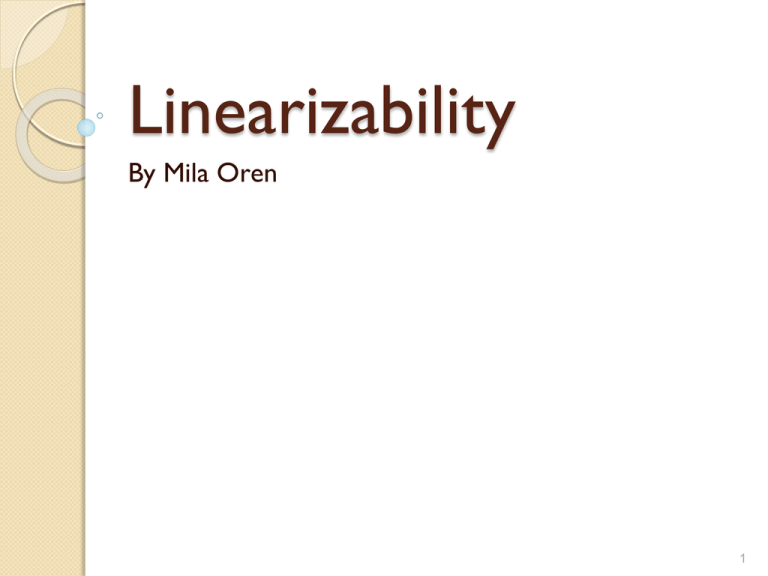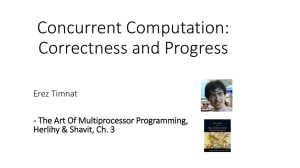Linearizability
advertisement

Linearizability
By Mila Oren
1
Outline
Sequential and concurrent specifications.
Define linearizability (intuition and formal model).
Composability.
Compare linearizability to other correctness
condition.
2
Motivation
• An
object in languages such as Java and C++ is a
container for data.
• Each object provides a set of methods that are the
only way to manipulate that object’s state.
• Each object has a class which describes how its
methods behave.
• There are many ways to describe an object’s behavior,
for example: API.
3
Motivation
In a sequential model computation, where a single
thread manipulates a collection of objects, this works
fine.
• But, for objects shared by multiple threads, this
successful and familiar style of documentation falls
apart!
• So that is why we need ‘Linearizability’ to describe
objects.
• Linearizability is a correctness condition for
concurrent objects.
•
4
Motivation
It permits programmers to specify and reason about
concurrent objects using known techniques from the
sequential domain.
• Linearizability provides the illusion that each
operation applied by concurrent processes takes effect
instantaneously between its invocation and its
response.
•
5
Concurrent objects
Consider a FIFO queue:
q.enq(
)
q.deq() /
6
Here is one implementation of a concurrent FIFO
queue:
class LockBasedQueue<T> {
int head, tail;
T[] items;
Lock lock;
public LockBasedQueue(int capacity) {
head = 0; tail = 0;
lock = new ReentrantLock();
items = (T[]) new Object[capacity];
}
7
deq operation:
public T deq() throws EmptyException {
lock.lock();
try {
if (tail == head)
throw new EmptyException();
T x = items[head % items.length];
head++;
return x;
This implementation
} finally {
should be correct
lock.unlock();
because all modifications
}
are mutual exclusive (we
}
use a lock)
8
Let’s consider another implementation:
Wait-free 2-thread Queue
public class WaitFreeQueue {
int head = 0, tail = 0;
items = (T[]) new Object[capacity];
So, how do
we know if it
is “correct”?
Here
modifications
are not
mutual
exclusive…
public void enq(Item x) {
if (tail-head == capacity) throw
new FullException();
items[tail % capacity] = x; tail++;
}
public Item deq() {
if (tail == head) throw
new EmptyException();
Item item = items[head % capacity]; head++;
return item;
}}
9
Defining concurrent queue
implementations:
In general, to make our intuitive
understanding that the algorithm is correct
we need a way to specify a concurrent
queue object.
• Need a way to prove that the algorithm
implements the object’s specification.
•
10
Correctness and progress
• There
are two elements in which a
concurrent specification imposes terms on
the implementation: safety and liveness, or
in our case, correctness and progress.
• We will mainly talk about correctness.
11
Sequential Specification
We use pre-conditions and post-conditions.
• Pre-condition defines the state of the object before
we call the method.
• Post-condition defines the state of the object after we
call the method. Also defines returned value and thrown
exception.
deq
method
Pre-condition:
Post-condition:
This makes your life easier, you don’t need
queue is not empty.
• Returns first item in queue.
to think about interactions between
• Removes first item in queue.
methods and you can easily add new
methods without changing
descriptions of
Pre-condition:
Post-condition:
old methods.
queue is empty.
• Throws EmptyException.
•
Queue state is unchanged.
12
Concurrent Specifications
• We
need to understand that methods here “take time”.
• In sequential computing, methods take time also, but we
don’t care.
• In sequential: method call is an event.
• In concurrent: method call is an interval.
•
Methods can also take overlapping time.
Method call
Method call
Method call
time
13
Sequential vs. Concurrent
Sequential
Concurrent
Each method described
independently.
Need to describe all possible
interactions between methods.
(what if enq and deq overlap? …)
Object’s state is defined between
method calls.
Because methods can overlap, the
object may never be between
method calls…
Adding new method does not affect Need to think about all possible
older methods.
interactions with the new method.
14
Here we come – Linearizability!
•A
way out of this dilemma: The Linearizability
Manifesto:
Each method call should appear to “take effect”
instantaneously at some moment between its invocation
and response.
This manifesto is not a scientific statement, it
cannot be proved or disapproved. But, it has
achieved wide-spread acceptance as a correctness
property.
•
15
Here we come – Linearizability!
• An
immediate advantage of linearizability is that
there is no need to describe vast numbers of
interactions between methods.
• We can still use the familiar pre- and postconditions style.
• But still, there will be uncertainty.
• example: if x and y are enqueued on empty FIFO
queue during overlapping intervals, then a later
dequeue will return either x or y, but not some z or
exception.
16
Linearizability
Linearizability has 2 important properties:
• local property: a system is linearizable iff each
individual object is linearizable. It gives us
composability.
non-blocking property: one method is never forced
to wait to synchronize with another.
•
17
So why the first implementation
was obviously correct?
Let’s try to explain the notion “concurrent”
via “sequential”:
lock()
So actually
we got a
“sequential
behaviour”!
lock()
q.enq
q.deq
unlock()
unlock()
time
18
Linearizability is the generalization of this
intuition to general objects, with or without
mutual exclusion.
• So, we define an object to be “correct” if this
sequential behavior is correct.
•
To reinforce out intuition about
linearizable executions, we will review a
number of simple examples:
19
Examples(1)
Is this linearizable?
Yes!
q.enq(x)
q.enq(y)
q.deq(y)
q.deq(x)
time
20
Examples(1)
What if we choose other points of
linearizability?
q.enq(x)
q.enq(y)
q.deq(y)
q.deq(x)
time
21
Examples(2)
Is this linearizable?
No!
q.enq(x)
q.deq(y)
q.enq(y)
time
22
Examples(3)
Is this linearizable?
Yes!
q.enq(x)
q. deq(x)
time
23
Examples(4)
Here we got multiple
orders!
Is this linearizable? Yes!
Option2:
Option1:
q.enq(x)
q.deq(y)
q.enq(y)
q.deq(x)
time
24
Read/Write registers
Is this linearizable?
No!
Write(0)
In this point, we
conclude that write(1)
has already occurred.
Read(1)
Write(2)
Write(1)
Read(0)
time
25
Read/Write registers
What if we
change to
Read(1)?
Is this linearizable?
No!
Write(0)
Read(1)
Write(2)
Write(1)
Read(1)
Read(0)
time
26
Read/Write registers
Is this linearizable?
Yes!
Write(0)
Write(2)
Write(1)
Read(1)
Read(0)
time
27
Formal model
• This
approach of identifying the atomic step where
an operation takes effect (“linearization points”) is
the most common way to show that an
implementation is linearizable.
• In some cases, linearization points depend on the
execution.
• We need to define a formal model to allow us to
precisely define linearizability (and other
correctness conditions).
28
Formal model
• We
split a method call into 2 events:
• Invocation: method names + args
• q.enq(x)
• Response: result or exception
• q.enq(x) returns void
• q.deq() returns x or throws emptyException
29
Formal model
•
Invocation notation: A q.enq(x)
• A – thread
• q – object
• enq – method
• x – arg
•
Response notation: A q: void , A q: empty()
• A – thread
• q – object
• void – result, exception
30
History
A sequence of invocations and responses. It
describes an execution.
H=
A q.enq(3)
A q:void
A q.enq(5)
B p.enq(4)
B p:void
B q.deq()
B q:3
31
Definitions
Invocation and Response match if:
thread names and object names agree.
•
A q.enq(3)
A q:void
And this is what
we used before as:
q.enq(3)
32
Definitions
•
Object projection:
H| q=
A q.enq(3)
A q:void
A q.enq(5)
B q.deq()
B q:3
• Thread
projection:
H| A =
A q.enq(3)
A q:void
A q.enq(5)
33
Definitions
•A
pending invocation is an invocation that
has no matching response.
A q.enq(3)
A q:void
A q.enq(5)
B q.deq()
B q:3
Complete history: history without pending
invocations.
•
34
Definitions
Sequential history: A sequence of matches,
can end with pending invocation.
•
A q.enq(3)
A q:void
B p.enq(4)
B p:void
B q.deq()
B q:3
A q:enq(5)
35
Definitions
• Well-formed
history: for each thread A, H|A
is sequential.
• Equivalent histories: H and G are equivalent
if for each thread A: H|A = G|A
H=
A q.enq(3)
B p.enq(4)
B p:void
B q.deq()
A q:void
B q:3
G=
A q.enq(3)
A q:void
B p.enq(4)
B p:void
B q.deq()
B q:3
36
Definitions
•A
method call precedes another if response
event precedes invocation event.
A q.enq(3)
B p.enq(4)
B p.void
A q:void
B q.deq()
B q:3
q.enq(3)
Notation:
m0 H m1
m0 precedes m1
(it defines partial order)
q.deq()
time
37
Definitions
•
Methods can overlap
A q.enq(3)
B p.enq(4)
B p.void
B q.deq()
A q:void
B q:3
q.enq(3)
q.deq()
time
38
Sequential Specifications
•This
is a way of telling if single-thread, singleobject history is legal.
• We saw one technique:
•Pre-conditions
•Post-conditions
•
but there are more.
39
Legal history
•A
sequential history H is legal if:
for each object x, H|x is in the
sequential specification for x.
•
for example: objects like queue, stack
40
Linearizability - formally
History H is linearizable if it can be
extended to history G so that G is
equivalent to legal sequential history S
where G S.
G is the same as H but without pending
invocations:
• append responses to pending
invocations.
• discard pending invocations.
41
Linearizability - formally
Let’s explain what is G S.
Example:
G = {ac,bc}
S = {ab,ac,bc}
a
b
c
time
42
Add
response to
this pending
invocation:
Example:
Discard this
pending
invocation: H =
A q.enq(3)
B q.enq(4)
B q:void
B q.deq()
B q:4
B q.enq(6)
A q:void
q.enq(3)
q.enq(4)
q.dec()
q.enq(6)
time
43
Example (cont’):
A q.enq(3)
B q.enq(4)
G = B q:void
B q.deq()
B q:4
A q:void
The equivalent sequent
history:
S=
B q.enq(4)
B q:void
A q.enq(3)
A q:void
B q.deq()
B q:4
q.enq(3)
q.enq(4)
q.dec()
time
44
Composability
Linearizability also gives us composability:
If we want to construct a new object from
linearizable objects, we can be sure that
our new object is linearizable too.
• why is it good?
It gives us modularity. We can prove
linearizability independently for each
object.
•
45
Composability
• Yet
another way to define linearizability:
History H is linearizable iff for every
object x, H|x is linearizable.
46
Linearizability in 1st implementation
Let’s return to our first implementation of FIFO queue.
Where are the linearization points?
public T deq() throws EmptyException {
lock.lock();
try {
if (tail == head)
throw new EmptyException();
T x = items[head % items.length];
head++;
return x;
} finally {
lock.unlock();
}
}
Linearization
points are
when locks
are released.
47
Linearizability in 2nd implementation
Let’s return to our wait-free implementation of FIFO queue.
Where are the linearization points?
public class WaitFreeQueue {
int head = 0, tail = 0;
items = (T[]) new Object[capacity];
public void enq(Item x) {
if (tail-head == capacity) throw
new FullException();
items[tail % capacity] = x; tail++;
}
public Item deq() {
if (tail == head) throw
new EmptyException();
Item item = items[head % capacity]; head++;
return item;
}}
Here
linearization
points are the
same for every
execution.
Linearization
points are
when fields
are modified.
48
Linearizability - summary
Linearizability is a powerful specification
tool for shared objects.
• Allows us to capture the notion of objects
being “atomic”.
• Each method call should appear to “take
effect” instantaneously at some moment
between its invocation and response.
• Uses sequential specification.
• gives us composability.
•
49
Alternative: Sequential Consistency
In order to understand better the
advantages of linearizability, let’s check
another specification method: “Sequential
Consistency”.
• Its definition is exactly the same, but it
differs from linearizability in one thing:
•
We do not demand this: G S.
50
Alternative: Sequential Consistency
History H is sequentially consistent if it can
be extended to history G so that G is
equivalent to legal sequential history S.
G is the same as H but without pending
invocations:
• append responses to pending invocations.
• discard pending invocations.
51
Alternative: Sequential Consistency
the demand of G S we do
not have to preserve real-time order.
• Now we can re-order non-overlapping
operations that are done by different threads.
•Without
52
Alternative: Sequential Consistency
Example in queue:
No!
Is it linearizable?
q.enq(x)
q.deq(y)
q.enq(y)
time
53
Alternative: Sequential Consistency
Is it sequentially consistent?
q.enq(x)
Yes!
q.deq(y)
q.enq(y)
time
54
Alternative: Sequential Consistency
In sequential consistency we lose the
composability property.
Let’s see a FIFO queue example:
Consider the following history H:
p.enq(x)
q.enq(y)
q.enq(x)
p.enq(y)
time
p.deq(y)
q.deq(x)
55
Alternative: Sequential Consistency
What is H|p?
p.enq(x)
q.enq(y)
q.enq(x)
p.enq(y)
p.deq(y)
q.deq(x)
Is it
sequentially
consistent?
Yes!
time
56
Alternative: Sequential Consistency
What is H|q?
p.enq(x)
q.enq(y)
q.enq(x)
p.enq(y)
p.deq()/y
q.deq()/x
Is it
sequentially
consistent?
Yes!
time
57
Alternative: Sequential Consistency
So we get order:
• Ordering imposed by p:
p.enq(y)
•Ordering
q.enq(x)
p.enq(x)
p.deq()/y
imposed by q:
q.enq(y)
q.deq()/x
time
58
Alternative: Sequential Consistency
Order imposed by both p,q:
p.enq(x)
q.enq(y)
q.enq(x)
p.enq(y)
p.deq()/y
q.deq()/x
If we combine the two orders, we can get a
circle.
Therefore the whole history is not
sequentially consistent!
time
59
The End...
Bibliography:
• “The Art of Multiprocessor Programming” by Maurice
Herlihy & Nir Shavit, chapter 3.
• http://www.cs.brown.edu/~mph/HerlihyW90/p463herlihy.pdf - “Linearizability: A Correctness Condition for
Concurrent Objects” by Herlihy and Wing, Carnegie
Mellon University.
60






